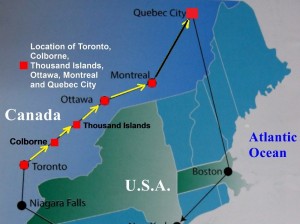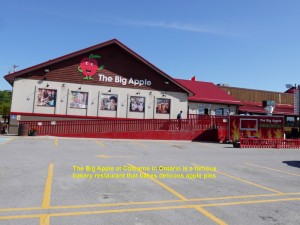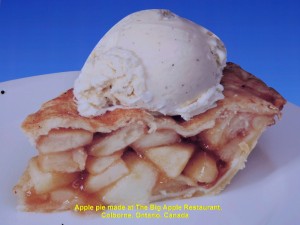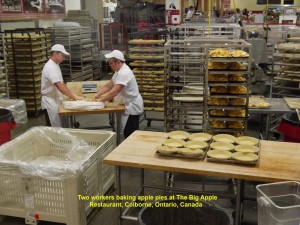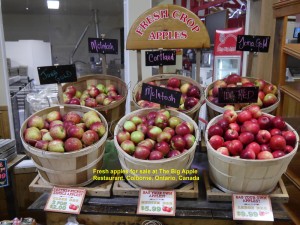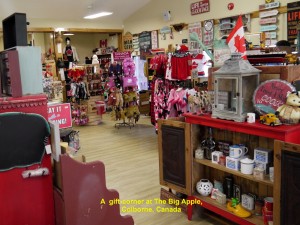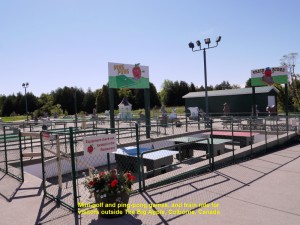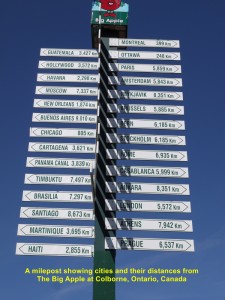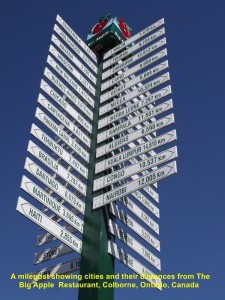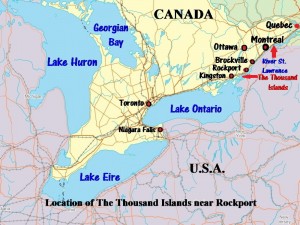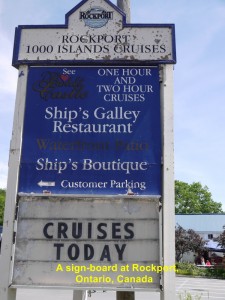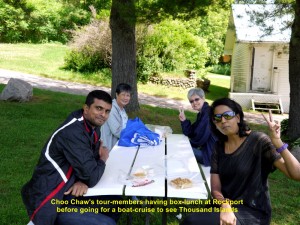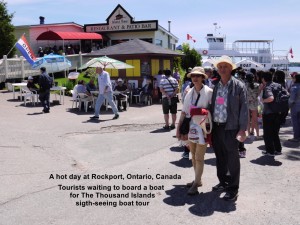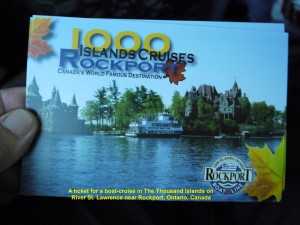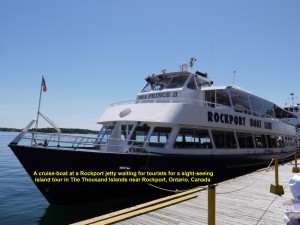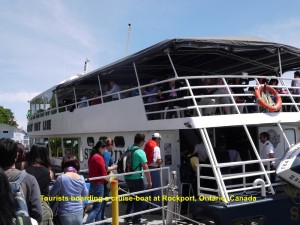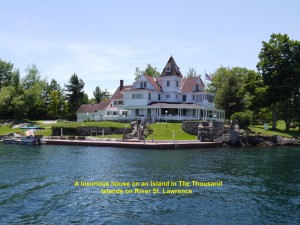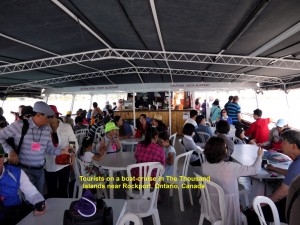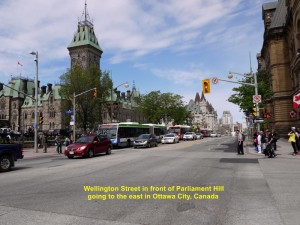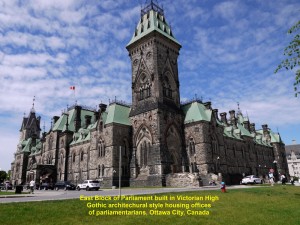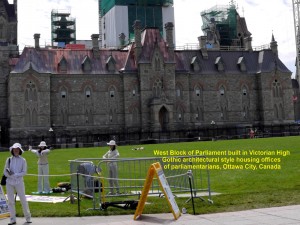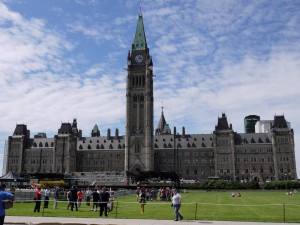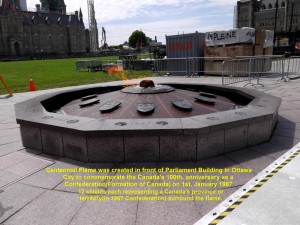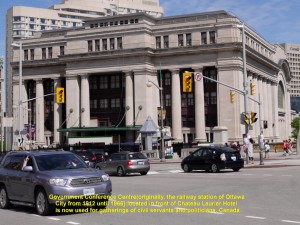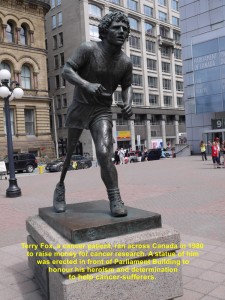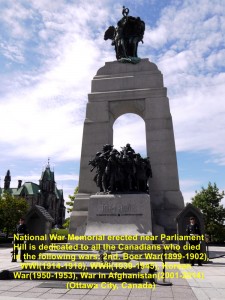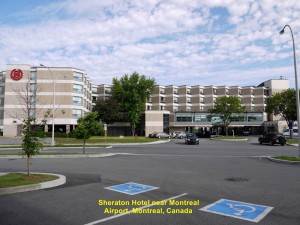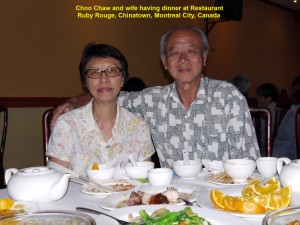U.S.A. and Canada East Coast Travel Part III(Colborne, Thousand Islands and Ottawa City)
U.S.A. and Canada East Coast Travel Part III(Colborne, Thousand Islands and Ottawa City)
Day 5 Wednesday, 17 June 2015
The Apple Farm, Colborne
At 8 in the morning we left Toronto and intended to to go to Quebec City in the north-east. After travelling for an hour we stopped for awhile for a toilet visit at a restaurant, The Big Apple, at Colborne.
This restaurant made large apple pies for sale. Besides, it sells many other apple products, like apple cider, apple chips, candy apples, caramel apples, apple bread and apple dumplings. Wine, chocolate, maple biscuits, souvenir gifts, clothes and many more are sold there, too.
Wooden Boards
The most interesting things for sale that amused me at this restaurant were the wooden boards with words on the walls. The words on them were words of advice, inspiration and family rules. I think the family rules are good for kids’ bedrooms as a frequent reminder for them to follow. For examples: “Say Please & Thank You”, “Love One Another”, “Work Hard” and “Keep Your Promises”.
Here are some photos of the wall-boards with family rules, sayings and inspirational words in the restaurant.
Outdoor Activites
Outside The Big Apple is an area for outdoor activities for visitors, like mini-golf and ping-pong games, and train-ride. Besides, there is a small orchard of young apple plants, garden and huge red apple structure that has an observation deck on its top.
Milepost
There is a tall milepost near the entrance of The Big Apple. It carries many names of cities in the world each pointing towards its location and showing its distance from the restaurant. Out of curiosity, I looked for a city in my country. I found one. It was Kuala Lumpur, the capital of my country, Malaysia, and it was 14 810 km away. I told myself that I was over halfway round the world.
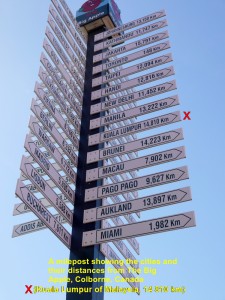
A milepost at The Big Apple, Colborne, Canada and note the city, Kuala Lumpur, in writer’s country, Malaysia
Rockport
Having spent an hour at The Big Apple, we moved on. An hour and a half later, we reached a small village, Rockport,where we would tour round a cluster of islands known as Thousand Islands on River St. Lawrence.
Thousand Islands
Located on St. Lawrence River between Brockville and Kingston in Ontario, Canada, over 1,800 islands ranging in area from 100 sq. km to 0.09 sq. m are, collectively, known as Thousand Islands. It is a scenic, tranquil place with unspoilt, lush, natural landscapes. Some of these islands have cottages and luxurious houses that attract city-dwellers to be away from the hustle and bustle of their cities in summer. They can get themselves involved in healthy out-door activities, like fishing, boating, swimming, kayaking and diving.
Boat-Cruise Round Thousand Islands
On arrival at Rockport, we had a box-lunch while our tour manager went to buy boat-tickets for us. Half an hour later, we all boarded a boat and went cruising on River St.Lawrence. We saw a large, beautiful, medieval castle, Boldt Castle, on a large island, and two islands, Zavikon Islands, connected by a bridge. Many tour-guides say, jokingly, that the bridge is the shortest international bridge in the world because it connects the two islands belonging to two different countries, Canada and U.S.A.. As we were cruising, continuously, we saw more islands with cottages and luxurious houses.
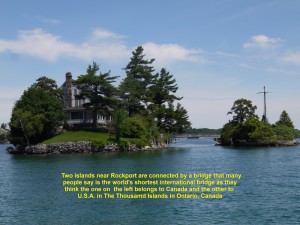
A short bridge connecting the two islands is thought to be the international bridge with Canada on the left and U.S.A. on the right.
After that enjoyable boat-ride round the Thousand Islands, we left for Ottawa City at 1.30 p.m.
Ottawa City
At 3.10 p,m. we arrived in Ottawa City in Ontario. It is the official national capital of Canada since 1867. Ottawa was chosen as the national capital by Queen Victoria in 1867 as it was between Montreal and Toronto, and was along the border of Ontario and Quebec(the centre of Canada at that time when only 4 provinces became a new nation). Besides, it was far from the American border and was safe from attacks.
In this city, there are several heritage buildings, monuments, museums, historic sites and landmarks.
Parliament of Canada
On arrival at the capital, we went straight to the historic site, Parliament Hill and its surroundings, for a short visit. First, we went to see the Parliament of Canada on the Parliament Hill along Wellington Road.
East and West Blocks
The Parliament consists of three buildings which are the East Block, the Centre Block and the West Block. The East Block and West Block were both built in Victorian High Gothic Revival architectural style during the same time(1859-1865). Both house the parliamentarians’ offices.
Centre Block
The Centre Block was built in 1917-1920 to replace the old one that was destroyed by fire in 1916. It is home to the Senate, the House of Commons and the Library of Parliament. The parliamentarians meet here to discuss, debate, define, decide and celebrate.
In the middle of the Centre Block is a tall tower with a clock known as The Peace Tower. Built in 1919-1927, the tower is dedicated to over 65 000 Canadian soldiers who died in WWI(1914-1918).
Centennial Flame
In front of the Parliament is a Centennial Flame created to commemorate the 100th. anniversary as a confederation(Formation of Canada) on 1 January 1967. Round the flame are 12 shields each representing a province or territory.
Langevin Block
Looking across Wellington Road, I saw a brown building built in 1884 in French Empire architectural style. It houses the Prime Minister’s office and Privy Council office.
Roving Information Officer
Near the Centennial Flame I met a lady roving information officer in navy blue with a white question mark. She carried an electronic tablet that contained information about the historic landmarks and history of Canada. She was a friendly and helpful officer.
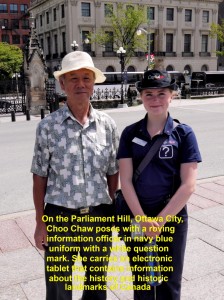
Choo Chaw posing with a friendly and helpful roving information officer in front of the Parliament of Canada, Ottawa

Langevin Block, constructed in 1884, facing the Parliament of Canada and housing the Prime Minister’s office and Privy Council office
Then I went alone to nearby places to look for anything that was interesting as I had little time left to look around. I was glad that I came across the following:
a. Rideau Canal
Rideau Canal, a 202 km-waterway with stepped locks, is one of the landmarks of Ottawa City. Located near the Parliament Hill, it was constructed in 1828 to connect the St. Lawrence River to the Ottawa River as a precautionary measure in case of war with the Americans. In 2007 it was designated as a UNESCO World Heritage Site.
b. Fairmont Chateau Laurier
On a bank of Rideau Canal stands a huge, impressive-looking building that looks like a castle. It was built in French Gothic Chateauesque architectural style in 1912 as a hotel with 429 guest-rooms
c. Government Conference Centre
Opposite Fairmont Chateau Laurier is an old building. From 1912 until 1966, it was used as a city railway station. It is now used as a place for gatherings of government servants and politicians.

Langevin Block housing the Prime Minister’s office and Privy Council office along Wellington Road, Ottawa, Canada
d. Statue of Sir Wilfrid Laurier(1841-1919)
Sir Wilfrid Laurier was the 7th. Prime Minister of Canada for 15 years. One of the greatest statesmen and the longest serving Prime Minister in Canada. I found that statue behind East Block of the Parliament of Canada on the Parliament Hill.
“The Fight for Canada 1812-1815” or “War of 1812” Monument
This monument is next to the statue of Sir Wilfrid Laurier behind East Block of the Parliament of Canada. It is known as “The Fight for Canada, 1812-1815” or “War of 1812”, but the Toronto sculptor, Adrienne Alison, named his creation as “Triumph Through Diversity”. He thought that it was the combined efforts of people from various walks of life who fought on land and water that saved their country, Canada, from the Americans during the 1812-1815 War.
The monument shows a Metis fighter firing a cannon, a British regular aiming a musket, a Canadian militiaman raising his arm in triumph, a First Nation warrior pointing to the distance, a royal Navy sailor pulling a rope and a woman bandaging the arm of a Voltigeur.
e. Statue of Terry Fox(1958-1981)
Terry Fox was a well-known Canadian who tried to run across his country to raise money for cancer research. In 1980 he started his run from St. John’s in Newfoundland even though he had cancer and a prosthetic leg. After running for 5 373 km in 143 days, he stopped running at a place near Thunder Bay in Ontario in 1980. It was because his left leg was made worse by cancer. A few months later he passed away.
In 1983, a statue of him created by John Hooper, was erected near Langevin Block to honour him for his heroism, courage and determination to help cancer-researchers.
His good deed inspires lots of people to participate in the “Terry Fox Run”, annually, in over 50 countries to raise funds for cancer research.
f. National War Monument
The National War Memorial is located between Rideau Canal and Langevin Block. Erected in 1939, it was dedicated by King George VI of England to the Canadian soldiers who died in WWI(1914-1918). Later, this memorial was dedicated to Canadian soldiers who died in other wars, viz. Second Boer War(1899-1902), WWII(1939-1945), Korean War(1950-1953) and war in Afghanistan(2001-2014).
A grave of an unknown soldier is created at the base of the memorial. It is dedicated to the past, present and future soldiers.
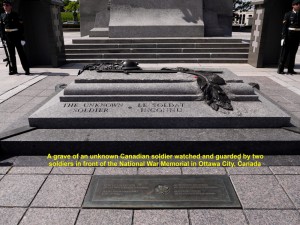
A grave of an unknown soldier at the National War Memorial dedicated to the past, present and future soldiers, Ottawa, Canada

Statues of Canadian soldiers who fought in WWI(1914-1918) of the National War Memorial, Ottawa, Canada
Statues around National War Memorial
Around the National War Memorial, there are several statues erected to honour those Canadians who had made invaluable contributions to their nation.
Here are some of them I came across at the National War Memorial.
Statue of Pierr Le Moyne d’Iberville(1661-1706)
Born in Montreal, Pierr Le Moyne d’Iberville was a great commander who had courage to attack three English vessels in Hudson Bay in 1697. He sank one, boarded another and captured their outpost at York Fort near Toronto.
Statue of Lt. Colonel Charles-Michel d’Irumberry de Salaberry(1778-1829)
In 1813, Salaberry defeated a superior American force at the Battle of Chateauguay and saved Lower Canada from the American Invasion during the War of 1812.
Statue of Andrew Mynarski(1916-1944)
Mynarski was a pilot officer who tried to save his rear gunner on his burning Lancaster bomber, but failed to do so during WWII(1939-1945). The gunner, miraculously, manged to save himself. Mynarski died of his burns, later. That statue is erected to honour his heroic deed.
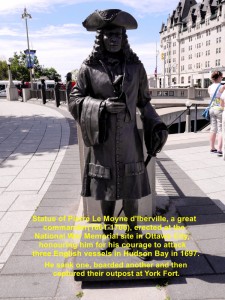
Statue of Perr Le Moyne d’Iberville(1661-1706), a great commander, who, courageously, attacked 3 English vessels in Hudson Bay in 1697
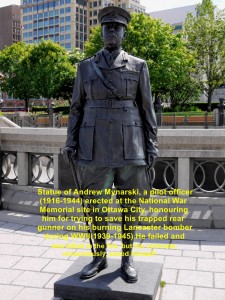
Statue of Andrew Mynarski, a pilot officer, who treied to save his trapped rear gunner on his burning bomber during WWII(1939-1945)

Statue of Lt. Colonel Charles-Michel d’Irumberry de Salaberry(1778-1829) who defeated Americans at the Battle of Chateauguay during the War of 1812
Statue of Thyayendanegeal(Joseph Brant, 1742-1807)
Thyayendanegeal was “a notable Mohawk warrior, statesman, and provincial war chief of the six nations he led his people in support of the British. After the war, he brought his people to Canada to settle near where Brantford now stands.”
Statue of Laura Secord(1775-1858)
Laura Secord warned the commander of a Beaver Dams British camp of an impending American attack during the War of 1812. War of 1812 was fought between the U.S.A. and the British, and it lasted for 2 years and 8 months.
Paying Respect to Fallen Soldiers
Before I left the National War Memorial, I saw a soldier in dark green uniform standing in front of the grave of the unknown soldier paying respect to all the fallen Canadian soldiers who had fought overseas. Two soldiers at their sentry-boxes were watching him.
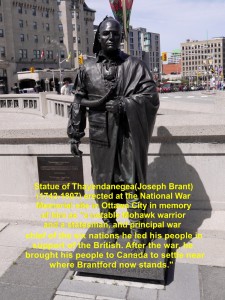
Statue of Thayendanegea(Joseph Brant, 1742-1807), a notable Mohawk warrior, statesman and principal war chief of the 6 nations in support of the British

A soldier in dark green uniform paying respect to all the Canadian soldiers in many wars they had fought overseas

Statue of Laura Secord(1775=1868) who warned the commander of Beaver Dams British Camp of an impending American attack during the War of 1812
Departure for Montreal City
At 4 p.m. we left Ottawa City for Montreal City in the east. Two hours later, we arrived in the city and went straight to a Chinese restaurant known as Red Ruby Rouge in Chinatown to have dinner.
Sheraton Hotel
After dinner, we went to a hotel near the Montreal Airport in the outskirt of the city called Sheraton and stayed there for a night.
Previous / Home / Next
U.S.A & Canada East Coast Travel
Part I Philadelphia & Washington D.C.
Part II Niagara Falls & Toronto City
Part III Colborne, 1000 Islands & Ottawa City
Part IV Montreal & Quebec City
Part VII Woodbury, JFK Airport & Home
Comments
Tell me what you're thinking...
and oh, if you want a pic to show with your comment, go get a gravatar!

